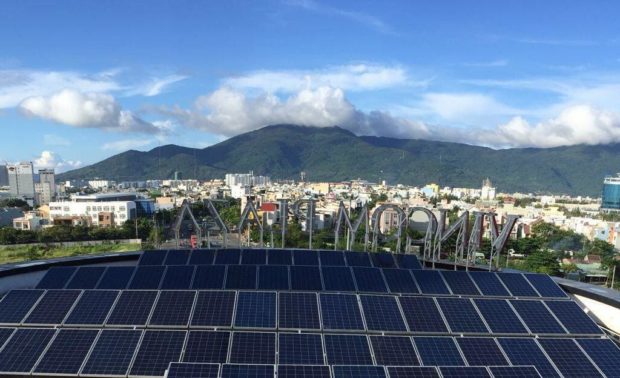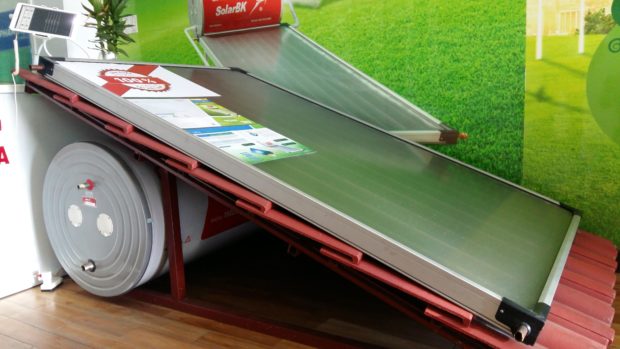Vietnam’s Da Nang lights up with solar power
DA NANG, Vietnam — In an effort to become a ‘green’ city by 2025, Da Nang has cut 12,000 tons of carbon emissions by introducing environmentally-friendly electric cars and household solar-powered water heaters.
Pham Ngoc Cong covered the 12-square-meter roof of his story home with solar panels to generate power for his family’s daily needs. The renewable energy system has helped Cong cut his household’s electric consumption by 30 percent each month, while cooling the penthouse during the scorching heat of summer.
The grid-tie solar power system produces 12 kilowatts per hour, supplying enough power for all electrical equipment including high consumption air conditioners and refrigerators, while solar-powered water heaters provide 24-hour hot water for family use.
“It’s saved me quite a bit of money. I used to pay VND2 million (US$88) each month for my family’s use from the city’s grid, but I pay just VND1 million ($44) since the top-roof solar power system was installed two years ago,” Cong said.
“Meanwhile, three water heaters, which were powered by solar energy, costs almost nothing from the power grid in summer when the sunlight is at its maximum between 9am and 4pm,” he explained, adding that the renewable energy only loses capacity on long rainy days during the rainy season.
Cong said the central region is sunny almost all year, so the solar power system is seen as one of the most effective solutions to ease carbon emissions while saving money and developing new power plants in the future.
He said renewable energy sources, including solar and wind power, are a smart choice in Viet Nam as the country focuses on its sustainable development.
Cong said his family’s solar power system was built at a total cost of more than VND100 million ($4,400), and the amount was paid in installments over 60 months.
Saving money is not just a big bonus for local residents, but it could help raise awareness about environmental protection and Greenhouse Gas (GHG) emissions from household electrical equipment.
Nguyen Minh Vu, director of the Da Nang-based Bach Khoa Solar Power Investment and Development Joint-stock Corporation (SolarBK), said the development of household solar power systems in the city would help reduce carbon emissions, when a 3.5kWh solar power system cuts 2kg of carbon rather than rely on other power plants (hydro-power and thermo-power plants).
Vu said more than 100 household solar power projects had been installed in Da Nang, with total capacity of 500kWp (kilowatt peak), cutting 3.5 tonnes of carbon emissions each day.
“The household ‘green’ power system can be seen as effective in long-term investment as the initial outlay is quite high. A minimum 2kWp system can be built on a house roof with investment of VND59 million ($2,600), producing 240kW per hour each day,” he said.
“This means that a family can pay around VND130,000 ($5.7) rather than VND500,000 ($22) for national grid use each month,” Vu explained.
The Da Nang City’s technology and science college was the first location in the city to develop a solar power system on top of its building, supplying 75,000kWh each year from 160-solar panels and cutting carbon emissions by 48,000 tonnes.
Architect Mai Ngoc Phuoc said solar power and solar-generated water heaters had been included in all designs of new buildings in Da Nang.
“We try to persuade our customers to add ‘green’ energy systems (solar power and water heaters) for long-term savings, while cooling the apartments as well as easing GHG emissions,” Phuoc said.
Policy
The Government issued a decision on pricing that aims to encourage the development of solar power projects in 2017.
It means that the output of solar power projects will be purchased for VND2,086 (9.35 US cents) per kWh (excluding VAT), deemed a profitable rate for investors.
According to Da Nang city’s Industry and Trade Department, 90 per cent of local people expect to build household solar power systems and sun-powered water heaters.
The department said around 30 per cent of the city’s population had used solar powered heaters, while 20 five-star hotels and resorts had been using solar powered heaters to save money and as an environmentally-friendly solution.
The Foreign Investment Agency under the Ministry of Planning and Investment, said only 16 foreign-invested green energy projects were operating in Viet Nam as of the end of 2016, with total registered capital of $778 million. Of these just 18 per cent were investing in solar power.
Solar power project investors would be eligible for various other incentives, especially support related to land, investment capital and import and corporate income tax, the agency said.
By the end of July 2017, hundreds of solar energy projects had been registered in Viet Nam with total capacity of around 17,000MW.
Mai Van Quy, a solar power expert, said the investment rate for the development of renewable energy was still higher than fossil fuels, so it needed encouragement and incentive policies from the government in order to develop renewable energy on a wide scale.
Quy said the Electricity Group of Viet Nam (EVN) could buy solar power from household systems rather than building new power plants to serve increasing power demands.
“EVN could save hundreds of billions of dong for building more power plants to fill an annual 10 per cent increase in power use, if it buys solar power from households,” Quy said.
“It’s a multi-benefit solution for both energy demands and environmental protection. Residents can use a cheap and ‘clean’ energy, while cooling air around their homes. Public sites including parks, traffic lights or decorative panels could use ‘green’ energy with nano-technology devices,” Quy suggested.
Off-grid
Islanders living on An Binh Islet, 30km off the coast of central Quang Ngai Province, started using 24-hour power after a solar power system was launched on the island last year.
Eighty-year-old islander Bui Ma said residents could use electricity around the clock from local solar power systems.
“We used to have power for just seven hours from diesel generators. However, it was very costly,” Ma said.
“In 2012, we used water from desalination station to ease a clean water shortage in summer, and now the islet is lit up with ‘clean’ power,” he said.
Solar power systems have been installed at public sites in Da Nang to provide free electricity for mobile phones and advertisements for commuters and tourists at public bus stops and parks.
The city also plans to build the first 4.4MWp solar farm on a disused dump in Lien Chieu District, which would supply 7.7 million kWh per year to the city’s power grid, while reducing 5,000 tonnes of carbon discharge each month.
Phan Thi Hien, from the city’s Department of Natural Resources and Environment, said solar power promotion would be a priority solution for Da Nang in reducing 25 per cent of carbon emissions by 2030.
She said industrial zones were urged to adopt new technology to save energy and renewable energy was seen as a smart choice.
Da Nang has great renewable energy potential, with a 90km coastline, 2,000 hours of sunlight per year and an average wind speed of 3m per second.
Experts from an EU consultants group shared the results of a four-month pilot project on rooftop solar power in Da Nang City’s Hoa Cam industrial zone. Industrial parks are good places to build solar panels because they have large rooftops and strong electrical connections already available.
















